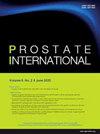Comparisons of three scoring systems based on biparametric magnetic resonance imaging for prediction of clinically significant prostate cancer
IF 2.6
2区 医学
Q2 UROLOGY & NEPHROLOGY
引用次数: 0
Abstract
Purpose
In this study, we aimed to validate and compare three scoring systems based on biparametric magnetic resonance imaging (bpMRI) for the detection of clinically significant prostate cancer (csPCa) in biopsy-naïve patients.
Method
In this study, we included patients who underwent MRI examinations between January 2018 and December 2022, with MRI-targeted fusion biopsy (MRGB) as the reference standard. The MRI findings were categorized using three bpMRI-based scorings, in all of them the diffusion-weighted imaging (DWI) was the dominant sequence for peripheral zone (PZ) and T2-weighed imaging (T2WI) was the dominant sequence for transition zone (TZ). We also used the Prostate Imaging Reporting and Data System version (PI-RADS) v2.1 to evaluate each lesion. For each scoring, we calculated the sensitivity, specificity, negative predictive value (NPV), positive predictive value (PPV), and area under the receiver operating characteristic (ROC) curves (AUC).
Results
The calculated AUC for three bpMRI-based scorings were 83.2% (95% CI 78.8%–87.6%), 85.0% (95% CI 80.8%–89.3%), 82.9% (95% CI 78.4%–87.5%), and 86.0% (95% CI 81.8%–90.1%), respectively. Scoring 2 exhibited significantly superior performance than scoring 1 (P = 0.01) and scoring 3 (P < 0.001). Moreover, the accuracy of scoring 2 was not decreased significantly as compared to PI-RADS v2.1 (P = 0.05). There was no significant difference between 3 bpMRI-based scorings and with PI-RADS in TZ. However, although scoring 2 yielded the highest AUC, it was still notably inferior to PI-RADS (P = 0.02).
Conclusion
All three bpMRI-based scorings demonstrated favorite diagnostic accuracy, and scoring 2 performed significantly better than the other two bpMRI-based scorings. Notably, scoring 2 was not significantly inferior to the full-sequence PI-RADS v2.1 in terms of sensitivity and specificity.
基于双参数磁共振成像的三种评分系统在预测具有临床意义的前列腺癌方面的比较
在这项研究中,我们旨在验证和比较三种基于双参数磁共振成像(bpMRI)的评分系统,用于检测活检无效患者中具有临床意义的前列腺癌(csPCa)。在这项研究中,我们纳入了在2018年1月至2022年12月期间接受磁共振成像检查的患者,并以磁共振成像靶向融合活检(MRGB)作为参考标准。核磁共振成像结果采用基于bpMRI的三种评分方法进行分类,其中扩散加权成像(DWI)是外周区(PZ)的主要序列,T2加权成像(T2WI)是过渡区(TZ)的主要序列。我们还使用前列腺成像报告和数据系统版本(PI-RADS)v2.1 对每个病灶进行评估。我们计算了每种评分的敏感性、特异性、阴性预测值(NPV)、阳性预测值(PPV)和接收者操作特征曲线(ROC)下面积(AUC)。计算得出的基于 bpMRI 的三种评分的 AUC 分别为 83.2%(95% CI 78.8%-87.6%)、85.0%(95% CI 80.8%-89.3%)、82.9%(95% CI 78.4%-87.5%)和 86.0%(95% CI 81.8%-90.1%)。评分 2 的表现明显优于评分 1 ( = 0.01) 和评分 3 ( < 0.001)。此外,与 PI-RADS v2.1 相比,评分 2 的准确性也没有明显下降(= 0.05)。基于 bpMRI 的 3 种评分与 PI-RADS 在 TZ 方面没有明显差异。不过,虽然评分 2 的 AUC 最高,但仍明显低于 PI-RADS(= 0.02)。所有三种基于 bpMRI 的评分都显示出最理想的诊断准确性,而评分 2 的表现明显优于其他两种基于 bpMRI 的评分。值得注意的是,就敏感性和特异性而言,评分 2 并不比全序列 PI-RADS v2.1 差。
本文章由计算机程序翻译,如有差异,请以英文原文为准。
求助全文
约1分钟内获得全文
求助全文
来源期刊

Prostate International
Medicine-Urology
CiteScore
4.40
自引率
26.70%
发文量
40
审稿时长
35 days
期刊介绍:
Prostate International (Prostate Int, PI), the official English-language journal of Asian Pacific Prostate Society (APPS), is an international peer-reviewed academic journal dedicated to basic and clinical studies on prostate cancer, benign prostatic hyperplasia, prostatitis, and ...
 求助内容:
求助内容: 应助结果提醒方式:
应助结果提醒方式:


